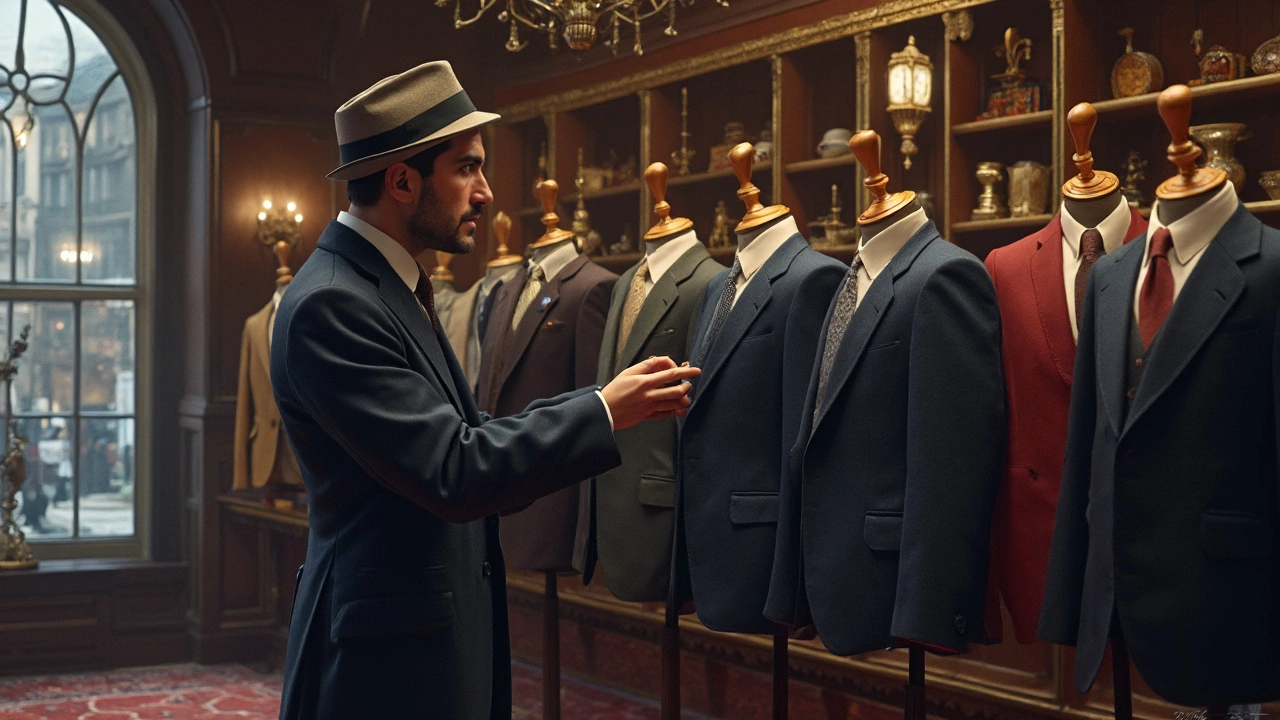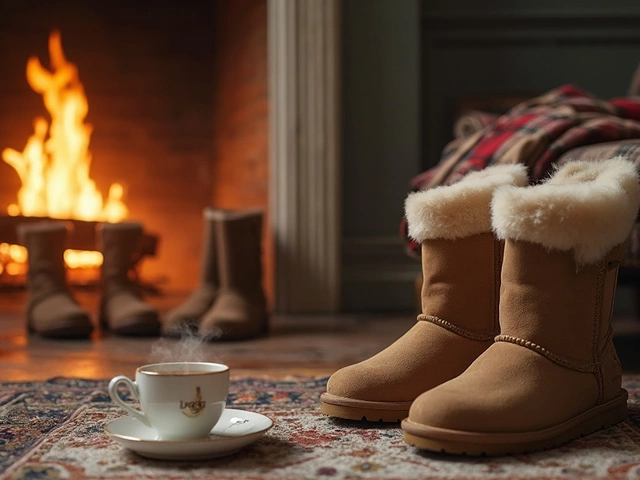What Should You Pay for a Good Suit?

- Cleo Fairchild
- 16 February 2025
- 0 Comments
Ever stood in a store, staring at a row of suits, and asked, "How much should I actually spend on one of these?" You're definitely not alone. Buying a suit can feel like a puzzle with a missing piece, especially if you're itching for both quality and a good deal.
First up, let's talk numbers. A decent suit can start around $300-$500, but why such a wide range? Fabric and construction make all the difference. Suits blended with synthetic fibers might be easier on the wallet but can lack breathability and comfort. On the other end, high-end wools, cashmere, or silk uplevel the price and feel.
But what's a suit without the right fit? Forget baggy shoulders or tight sleeves. Quality tailoring involves specifics like ensuring the jacket hugs your shoulders and the trousers have just the right break. Off-the-rack suits can often need alterations, so factor in an extra $50-$100 for a truly custom fit.
The Basics of Suit Pricing
When it comes to buying a men's suit, the price can swing dramatically. So, what gives? The cost of a suit is a dance between fabric choice, craftsmanship, brand, and even where you shop.
Fabric Matters
Let's start with fabric. It's the foundation of any suit. Cheaper options, like polyester blends, cost less but might not wear well over time. On the flip side, pure wool, especially if it's merino or super 100s wool, is pricier but offers breathability and comfort that's hard to beat. Suits made from luxury fabrics like cashmere or silk, might see their price tags soaring.
Construction and Craftsmanship
Construction makes all the difference too. A fused suit—where glue holds the fabric layers together—is generally more affordable but can lose shape easily. Half-canvassed suits offer a step-up in quality, providing better structure and durability. Then there's the full canvas, often found in luxury suits, offering the best fit and movement at a premium price.
Brand Influence
Brands play the pricing game as well. Established names can charge more not just for their quality, but for their reputation. A designer label might add several hundred dollars to the cost of a basic suit.
Where You Buy
Location matters, too. Buying from a department store might be pricier than sourcing directly from a manufacturer's warehouse outlet. If you have an eye for deals, online off-season sales can be a goldmine for scoring a quality suit at a fraction of the usual price.
Below is a basic comparison of the types of suits and their expected price range:
| Suit Type | Expected Price Range |
|---|---|
| Polyester Blend | $100 - $300 |
| Wool Blend | $300 - $500 |
| Pure Wool | $500 - $1000 |
| Luxury Fabrics (Silk/Cashmere) | $1000+ |
The key is understanding what you value most in a suit and aligning that with your budget. Quality often comes with a price, but with a keen eye, you can find a sweet spot that doesn't break the bank.
Quality Indicators to Watch For
If you're shelling out cash for a men's suit, you want to know it's worth it, right? Let’s break down the nitty-gritty of what makes a suit scream quality. Understanding these indicators will help you pick out a suit that fits right and lasts long.
Fabric Matters
First things first, the fabric. A quality suit often starts with good fabric. Look for words like wool, cashmere, or silk when checking labels. These materials breathe well and feel great, unlike synthetic blends that might be cheaper but can get stuffy and irritate the skin.
Stitching and Construction
Take a close look at the stitching. Are they even and tight? A quality suit will have neat, clean stitches. Pay attention to the lining too. A fully lined jacket improves the structure and feel. A common tip is to check the inside pocket for hand-stitching, a sign of quality craftsmanship.
"A well-made suit is all about the details – fabrics, buttons, seams – these speak volumes about quality," says tailor James Banks of Savile Row, a century-old tailoring hub.
Canvassing
Ever heard of canvassing? It's what gives the jacket its shape. A fully canvassed suit, where a layer of canvas fabric is sandwiched between the outer fabric and lining, molds to your body better over time. It's a hallmark of high-end suits but can also be found in mid-range options for those in the know.
| Quality Suit Feature | Description |
|---|---|
| Full Canvassing | Molds to body shape over time |
| Hand Stitching | Neat, clean, and durable |
| Natural Fabrics | Breathable and comfortable |
Button and Details
Buttons might seem minor but are telltale signs. Horn, bone, or mother-of-pearl buttons are usually found on higher-end suits. And don't forget the buttonholes – are they neat or fraying?
So, gear up with these tips, and you'll feel like a suit detective, identifying quality pieces that justify every penny you spend.

Tailoring and Fit
A great men's suit isn't just about the fabric and price. It's how it fits that really tells the story. The tailoring of a suit can change how you feel and how others see you. So, let's break down what you need to know about fit and tailoring.
Shoulders and Chest
Think of the shoulders as the backbone of your suit. They should hug your shoulders without drooping or pulling. If the shoulder pads extend beyond your natural shoulders, the fit is wrong. Similarly, the chest should allow for comfortable movement without looking like it's about to burst apart.
Sleeve Length
A rule of thumb is that the jacket sleeves should end right at your wrist bone, showing about half an inch of your shirt cuff. This detail adds that extra touch of sophistication.
Jacket Waist
When buttoned, the jacket should taper gently to your waist without pulling or leaving excessive room. It should create a sleek silhouette.
Pant Fit
Opt for trousers that complement your jacket. They should sit on your waist without the need for a belt. The pant length should touch the top of your shoes with a slight break.
Finding the Perfect Fit
- Off-the-rack: These suits are pre-made to fit standard sizes. Always account for alterations to refine the fit.
- Made-to-measure: Offers semi-custom options by adjusting a standard pattern to your measurements.
- Bespoke: Fully customized from scratch, offering precision but at a significantly higher cost.
Investing in tailoring even for off-the-rack suits can make a world of difference. Expect to spend anywhere from $50 to $200 for alterations to achieve that perfect look. Consider it an investment in feeling confident and making an impression.
Smart Shopping Tips
Shopping smart for a suit isn't just about spending less; it's about getting more for what you do spend. Here are some tried and true tips that'll help you snag a great deal without skimping on quality.
Know the Right Time to Buy
Timing is everything, right? This applies to buying suits too. Best times include post-holiday sales and during seasonal clearances, especially around January and July. Stores are moving out the old to make space for new collections, so discounts are your friend.
Shop Around
Be a little curious and explore various stores—both online and offline. Different retailers have varying prices for similar brands and styles. You may find a hidden gem in a department store or snag a deal at an outlet store.
Consider Off-season Purchases
You know the drill: swimwear in winter, coats in summer. This trick works for suits too, especially if you live in a place with distinct seasons. Buy winter suits in the summer and vice versa.
Look for Sales and Coupons
Sales events like Black Friday, Cyber Monday, and mid-season sales can offer heavy discounts. Fancy a free tip? Look for coupons or discount codes online before making that purchase, particularly if you're going the e-commerce route.
Don't Overlook the Alteration Costs
Alterations can make or break the whole experience. Even the best deal on a great suit isn't worth it if the fit's off and you have to spend a small fortune tailoring it. Ask your local tailor for pricing beforehand.
Here's a quick glance at potential alteration costs:
| Alteration Type | Cost Estimate |
|---|---|
| Jacket Sleeve Shortening | $30-$60 |
| Pants Hemming | $15-$25 |
| Slimming Pants | $30-$50 |
Making sure you account for these additional costs can help you better budget for your next suit purchase. And don't forget to use those savings to grab an extra tie or shirt to complement your new look! Shopping for a men's suit doesn't have to be overwhelming—you just need the right strategy!


